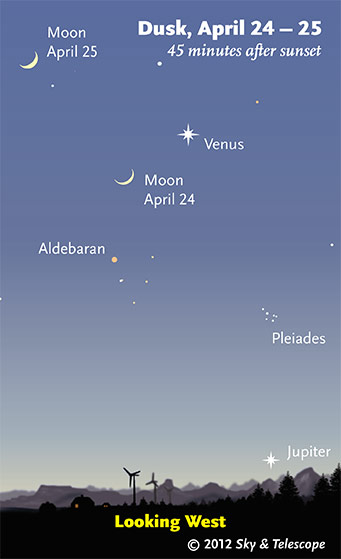Venus befriends the crescent moon after twilight tonight.
Take a look to the western sky as twilight fades this evening (April 24, 2012) to see Venus befriending the crescent Moon — just in time for my birthday! They’ll be the brightest objects in the darkening sky.

Sky & Telescope diagram
They appear separated by 6° (three or four finger-widths at arm’s length) as seen in twilight from North America. That means they’ll just fit into the view of many binoculars. In fact, good, firmly mounted binoculars or a small telescope can show that Venus is a tiny crescent. It’s facing the same way the crescent Moon faces: toward the illuminating Sun. Right now the Venus crescent is thicker than the lunar one; the side of Venus we see is 32% sunlit, compared to 12% for the Moon But Venus will continue to thin and lengthen throughout April and May, leading up to its long-awaited transit across the face of the Sun on June 5–6 (on the afternoon of June 5th for North America)..
If the air is clear this evening, you’ll notice that the Moon’s night face (interior to the crescent) is dimly glowing. What you’re seeing is earthshine: the light of the nearly full Earth that’s hanging in the Moon’s sky lighting the lunar landscape.
The Moon and Venus may look close together this evening, but they’re not. The Moon is just 1.3 light-seconds from us: 250,000 miles, less far than you may have driven cars in your lifetime. Venus is currently almost 200 times farther, at a distance of 4 light-minutes.
How can Venus display such a dazzling surface brightness in a telescope compared to the dull gray of the Moon — when they’re both just balls lit by the Sun?
First, the Moon’s surface is dark gray rock dust that reflects only 12% of incoming sunlight (about like fresh asphalt), while Venus is covered in white clouds that reflect 65% of the sunlight that hits them. Second, Venus is closer to the Sun than Earth and Moon are — so the sunlight at Venus is twice as intense.
As always, submit your photos of Venus, the Moon and any other celestial objects that make it through your camera lens to our Photo Gallery!
 1
1
Comments
actualit
April 25, 2012 at 3:41 am
If the air is clear this evening, you’ll notice that the Moon’s night face (interior to the crescent) is dimly glowing. What you’re seeing is earthshine: the light of the nearly full Earth that’s hanging in the Moon’s sky lighting the lunar landscape. Bangladesh news
The Moon and Venus may look close together this evening, but they’re not. The Moon is just 1.3 light-seconds from us: Bangladesh news 250,000 miles, less far than you may have driven cars in your lifetime. Venus is currently almost 200 times farther, at a distance of 4 light-minutes.
You must be logged in to post a comment.
You must be logged in to post a comment.